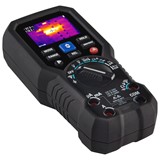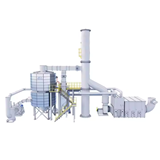Thermal imaging cameras have revolutionized the way industries operate by providing invaluable insights into temperature variations and heat patterns. These cameras are extensively integrated into industrial systems, enabling real-time monitoring, analysis, and predictive maintenance. The seamless connectivity of thermal imaging cameras with smart devices and other technologies has opened up new possibilities for remote monitoring and control. This article delves deeper into the integration and connectivity of thermal imaging cameras in industrial settings, exploring their applications, benefits, and potential contributions to Industry 4.0.
Integrating Thermal Imaging Cameras with Industrial Systems and Processes
The integration of thermal imaging cameras with industrial systems is a game-changer. By strategically placing these cameras within manufacturing plants, refineries, or production facilities, industries gain critical insights into equipment health, energy consumption, and potential hazards. This integration empowers businesses to optimize their processes, improve productivity, and enhance workplace safety.
Predictive Maintenance and Condition Monitoring
One of the primary advantages of integrating thermal imaging cameras is the implementation of predictive maintenance strategies. Instead of relying on fixed maintenance schedules, these cameras continuously monitor the temperature of critical machinery and equipment. When an abnormal temperature variation is detected, the system can trigger maintenance alerts, prompting technicians to investigate and address potential issues before they escalate. This proactive approach to maintenance minimizes unexpected downtime, reduces repair costs, and maximizes asset lifespan.
Quality Control and Defect Detection
Thermal imaging cameras play a vital role in quality control processes. By capturing thermal images of products during manufacturing, defects and irregularities can be easily identified. Whether it's a faulty component in an electronic device or an inconsistency in a chemical process, thermal imaging provides a non-invasive and efficient means of spotting defects. Consequently, manufacturers can maintain high product quality, reduce waste, and ensure compliance with industry standards.
Connecting Thermal Imaging Cameras to Smart Devices and Mobile Apps
With the advent of the Internet of Things (IoT) and the proliferation of smart devices, thermal imaging cameras can be connected to smartphones, tablets, and other mobile apps. This connectivity allows real-time access to thermal data from anywhere, empowering operators and engineers to monitor processes remotely. In case of temperature anomalies or critical events, instant alerts are sent to designated personnel, enabling timely interventions and preventing potential disasters.
Augmented Reality (AR) and Thermal Imaging
The integration of thermal imaging cameras with augmented reality technology opens up new dimensions of visualization and problem-solving. By overlaying thermal data onto live camera feeds or digital models, operators can quickly identify areas with abnormal temperature patterns, making it easier to detect potential issues. AR integration also facilitates more effective communication among teams, as everyone can view and understand thermal data in a visually intuitive manner.
Data Logging and Storage for Analysis and Reporting in Thermal Imaging Cameras
The volume of data generated by thermal imaging cameras can be substantial. To effectively analyze trends and patterns over time, proper data logging and storage are essential. Modern thermal imaging cameras are equipped with advanced data management systems that store and organize thermal images and temperature data. This data can be accessed later for in-depth analysis, generating valuable insights that aid in optimizing processes and making informed decisions.
Thermal Imaging and Remote Monitoring
Remote monitoring capabilities provided by thermal imaging cameras offer a significant advantage in various industries. In hazardous environments or hard-to-reach locations, these cameras can be installed to monitor temperature conditions without requiring physical presence. By providing real-time thermal data from remote locations, operators can assess critical infrastructure, detect anomalies, and respond promptly to potential emergencies.
Combining Thermal Imaging with Other Technologies
To further enhance the capabilities of thermal imaging cameras, they can be combined with other imaging technologies, such as visual imaging and infrared thermography. This integration offers a more comprehensive analysis of the observed scenes, as visual imaging provides context to thermal data. The combination of these technologies’ aids in better identifying and interpreting temperature patterns, allowing for more accurate assessments and decision-making.
Utilizing Thermal Imaging in Fire Prevention and Safety
Thermal imaging cameras are instrumental in fire prevention and safety applications. Firefighters use these cameras to detect hidden fires or hotspots within buildings, enabling them to locate the source of the fire more efficiently. Additionally, thermal imaging can be used in search and rescue operations, as it allows rescuers to identify human body heat in low-visibility or disaster-stricken areas.
Exploring IoT Integration and Industry 4.0 Applications of Thermal Imaging Cameras
As industries embrace the principles of Industry 4.0, the integration of thermal imaging cameras becomes even more critical. By incorporating IoT connectivity into thermal cameras, industries can create a network of smart sensors and devices that communicate seamlessly. These interconnected systems can facilitate real-time decision-making, automate processes, and optimize resource utilization. In the context of Industry 4.0, thermal imaging cameras contribute to the establishment of intelligent, self-monitoring production environments.
Collaboration Across Teams with Shared Thermal Data
In large industrial setups, multiple teams collaborate to ensure smooth operations. Thermal imaging cameras with shared access to thermal data promote cross-functional collaboration. Engineers, maintenance personnel, and safety officers can all access the same data, fostering a holistic approach to problem-solving and decision-making. This collaborative effort enhances the efficiency of industrial processes and contributes to a safer working environment.
Enhancing Energy Efficiency with Thermal Imaging
Beyond equipment monitoring and safety, thermal imaging cameras also aid in enhancing energy efficiency. By capturing thermal images of buildings and infrastructure, industries can identify areas of excessive heat loss or energy wastage. This information allows companies to implement energy-saving measures, such as improving insulation or optimizing heating and cooling systems, leading to significant cost savings and a reduced environmental impact.
Industrial Process Optimization with Thermal Imaging
Thermal imaging cameras are instrumental in optimizing various industrial processes. For example, in the manufacturing of electronic components, precise temperature control is critical to ensure product quality. Thermal imaging enables real-time monitoring of temperature variations during production, helping to maintain consistent quality and reduce the number of defective products. Similarly, in industrial ovens and furnaces, thermal imaging ensures uniform heating, reducing energy consumption and production time.
Unmanned Aerial Vehicles (UAVs) and Thermal Imaging
The combination of thermal imaging cameras with unmanned aerial vehicles (UAVs), also known as drones, has opened up new possibilities in industrial inspections. Drones equipped with thermal imaging capabilities can quickly survey large areas and identify hotspots or anomalies in structures such as pipelines, power lines, and solar panels. This technology allows for efficient inspections without the need for costly and time-consuming manual assessments.
Addressing Environmental and Wildlife Conservation Challenges
Thermal imaging cameras have proven to be valuable tools in environmental and wildlife conservation efforts. In conservation biology, these cameras are used to monitor animal populations, study behavior, and identify critical habitats. Additionally, thermal imaging helps track elusive species during nighttime surveys, contributing to a better understanding of biodiversity and aiding in wildlife protection.
Security and Surveillance Applications
Thermal imaging cameras play a significant role in security and surveillance applications. By detecting human body heat, these cameras can effectively monitor large areas for intruders, even in complete darkness. They are widely used in critical infrastructure protection, border surveillance, and perimeter security, providing an additional layer of safety in challenging environments.
Thermal Imaging in Medical Applications
Beyond industrial and security uses, thermal imaging cameras have found applications in the medical field. In healthcare settings, thermal imaging assists in diagnosing various conditions, such as circulatory issues, inflammation, and nerve damage. It is a non-invasive and radiation-free method, making it particularly useful in pediatric and geriatric care.
Training and Skill Development with Thermal Imaging
As thermal imaging technology becomes more accessible, training and skill development opportunities have also expanded. Industrial workers and technicians can undergo specialized training to operate thermal imaging cameras effectively and interpret thermal data accurately. This enhances their ability to identify potential issues, troubleshoot problems, and optimize industrial processes, resulting in a more skilled and efficient workforce.
Conclusion
The integration and connectivity of thermal imaging cameras have transformed industrial systems, making them more efficient, safe, and reliable. These cameras facilitate predictive maintenance, quality control, and real-time monitoring, allowing industries to operate at their full potential. With ongoing advancements in technology, the seamless integration of thermal imaging cameras with industrial processes will continue to drive progress in the Industry 4.0 era.



















